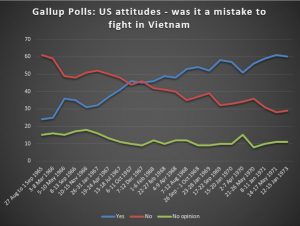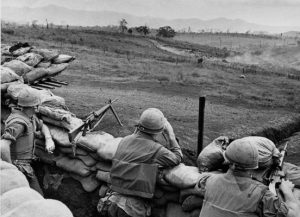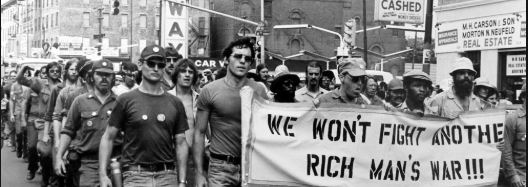By Bob Hall
Throughout the course of the Vietnam War, Gallup Polls were regularly conducted in the United States. Beginning in 1965 the polls asked a standard question:
In view of the developments since we entered the fighting in Vietnam, do you think the US made a mistake sending troops to fight in Vietnam?[1]
The graph below shows the polling results. The blue line shows the steady growth throughout the campaign of those who responded to the question by answering ‘yes, the US made a mistake’. The red line shows the steadily declining responses of those who answered ‘no, it was not a mistake to fight in Vietnam’. The green line shows those who expressed no opinion, one way or the other.

Compare this graph of US opinion about the war with the graph showing the attitudes expressed in Gallup Polls conducted in Australia shown in the article Gallup Polls #2 – Support for Vietnam deployment. The Gallup Polls conducted in Australia show that once the deployment of Australian forces had begun, it was always supported by more Australians than opposed it. In Australia, support for the deployment to Vietnam rarely dropped below 50% of those polled. On the few occasions when it did, it soon bounced back above the 50% mark.
The graph above shows that the attitudes of US citizens towards the fighting in Vietnam underwent a steady transformation throughout the course of the war. Initially, US citizens strongly supported the idea that it was not a mistake to fight in Vietnam. However, as the war continued and US military power was unable to achieve decisive victory, citizens increasingly came to see the fighting as a mistake.

US troops on the Khe Sanh defensive perimeter.
The point at which the ‘yes’ and ‘no’ lines cross is around October 1967, shortly after the Republic of Vietnam (South Vietnam) held its first Presidential election under its new democratic constitution passed into law in April 1967. It is also that period immediately prior to the shock of the Tet Offensive which began in late January 1968. The initial attacks of the Tet Offensive of 1968 shocked Americans despite HQ USMACV knowing that an offensive of some sort was coming. The attack on the US embassy in Saigon, and the battles in Saigon, Hue and at Khe Sanh which dragged on into February and in the case of Khe Sanh into mid-1968, added to this sense of gloom. From this point, the Democratic Republic of Vietnam (North Vietnam) increasingly targeted American domestic opinion in its efforts to achieve victory in Vietnam.
Notes:
[1] Mark Gillespie, ‘Americans Look Back at Vietnam War: Clinton becomes first U.S. president to visit Vietnam since the 1975 fall of Saigon’, in: https://news.gallup.com/poll/2299/americans-look-back-vietnam-war.aspx 6 March 2020.

